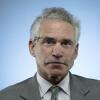Not just whom, but where, when
As Barack Obama and John McCain edge closer to naming their vice presidential picks, they have an important consideration to weigh beyond questions of credentials and compatibility: when and where to announce their choices.
The goal is to maximize favorable publicity -- and build excitement for the conventions -- without creating problems that could mushroom in the hothouse atmospheres of Denver and St. Paul, Minn.
With the Democratic convention opening Monday in Colorado, and Republicans following a week later in Minnesota, virtually every move the two presidential candidates make is being studied for signals of their intent. Both are believed to have whittled their vice presidential prospects to a very few, but only a small circle of advisors knows for certain.
Obama’s decision to appear Saturday in his home state of Illinois -- in Springfield, where he launched his White House bid -- immediately fueled talk he would be joined by his new running mate, creating a splash for the Sunday newspapers and TV talk shows.
Campaign officials, maintaining an unusually tight-lipped policy, had no comment.
The McCain camp has been similarly guarded, refusing to discuss speculation that the Arizona senator will announce his pick in the three-day window between the end of the Democratic convention and the start of the GOP gathering, in a bid to stop any Obama momentum.
Both candidates are expected to announce their selections in advance of their conventions, keeping with the practice of the last 20 years. Neither camp is saying so. But there is good reason to believe each would prefer to choose sooner rather than later: the last vice presidential candidate announced mid-convention was Dan Quayle, whose image never recovered from his rocky rollout at the 1988 GOP gathering.
“You’re taking the most active people in a national political party and putting them all under one roof, which creates the potential for a lot of volatility,” said Tad Devine, a Democratic veteran of several presidential campaigns. “With 15,000 journalists on hand, if anything goes wrong, it’s going to be hugely amplified.”
For that reason, Obama is expected to name his selection sometime in the next few days, though some suggested he could wait until next week to steer attention in Denver away from his vanquished primary opponent, Sen. Hillary Rodham Clinton, and her husband, former President Clinton. Obama’s list of finalists is thought to include Govs. Tim Kaine of Virginia and Kathleen Sebelius of Kansas and fellow Sens. Evan Bayh of Indiana and Joseph R. Biden Jr. of Delaware.
Obama might have liked to make his pick earlier. In 2004, Sen. John F. Kerry of Massachusetts announced his running mate, Sen. John Edwards of North Carolina, 20 days before the start of the Democratic convention and enjoyed nearly three weeks of positive news coverage.
“It’s really about shelf life,” said Devine, a strategist for Kerry’s campaign. “Can you turn the four days of the convention into a 10- or 12-day story?”
But Kerry wrapped up the nomination in February, giving him several months to vet prospective running mates. Obama, who dueled Clinton into early June, has had less than half that time to consider his options.
McCain, like Kerry, quickly captured his party’s nomination. He too is believed to have a short list, including Minnesota Gov. Tim Pawlenty and former Massachusetts Gov. Mitt Romney. But McCain has a strong incentive to wait until Obama has revealed his selection.
“Going second works to his advantage,” said Scott Reed, who ran Bob Dole’s 1996 presidential campaign. “He can adjust his final decision based on the Obama ticket.”
For that reason, McCain is expected to announce his decision no sooner than Aug. 29, the day after the end of the Democratic convention and, as it happens, his 72nd birthday.
It used to be that running mates were selected by convention delegates, who were free to disregard the preferences of the candidate at the top of the ticket. That changed in 1940, when President Franklin D. Roosevelt insisted, as a condition of seeking a third term, that he have Henry Wallace as his running mate.
With that precedent, presidential candidates began choosing their own running mates, and the custom soon took hold. Just a few conventions later, in 1956, Democrat Adlai Stevenson was criticized for leaving the vice presidential selection up to delegates.
“People expected him to choose his own running mate,” said Joel K. Goldstein, a St. Louis University expert on the vice presidency. “When he failed to do so, people said it proved he was not sufficiently decisive to be president.”
--
More to Read
Get the L.A. Times Politics newsletter
Deeply reported insights into legislation, politics and policy from Sacramento, Washington and beyond. In your inbox three times per week.
You may occasionally receive promotional content from the Los Angeles Times.







